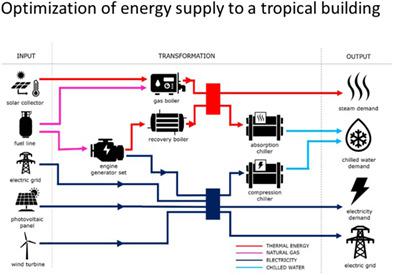当前位置:
X-MOL 学术
›
Int. J. Energy Res.
›
论文详情
Our official English website, www.x-mol.net, welcomes your
feedback! (Note: you will need to create a separate account there.)
Optimization of an integrated combined cooling, heat, and power system with solar and wind contribution for buildings located in tropical areas
International Journal of Energy Research ( IF 4.3 ) Pub Date : 2021-09-06 , DOI: 10.1002/er.7244 Filipi Maciel Melo 1 , Fabio Santana Magnani 2 , Monica Carvalho 3
International Journal of Energy Research ( IF 4.3 ) Pub Date : 2021-09-06 , DOI: 10.1002/er.7244 Filipi Maciel Melo 1 , Fabio Santana Magnani 2 , Monica Carvalho 3
Affiliation

|
Combined cooling, heat, and power systems present higher energy efficiency and consequent financial benefits due to the reduced consumption of energy resources. In addition, there is the possibility of combining renewable and non-renewable energy resources. This study develops an economic optimization to identify the optimal configuration and operation for an energy supply system. The optimal configuration is a subset of the available equipment, which includes solar collectors, fuel lines, electric grid, photovoltaic panels, wind turbines, gas boilers, engine-generator sets, recovery boilers, and absorption and compression chillers. The optimization method consists of four steps: pre-selection of the set of equipment to be evaluated, generation of all possible equipment combinations, optimization of the operation of each configuration based on a linear programming model, and exhaustive search to identify the lowest Net Present Value (objective function). A sensitivity analysis verified the optimal system in different β values, where β is a multiplier of the fuel (βfuel) and electricity (βele) tariffs. By systematically varying the β value, it is possible to identify the optimal system for different fuel and electricity tariffs. For example, for an optimization with βele = 1 and βfuel = 1.2, this assumes that the electricity tariff has not changed and the fuel tariff has increased by 20%. The optimal system (optimization with βfuel = 1 and βele = 1) meets the electricity and chilled water demands with electricity from the electric grid. A gas boiler meets the hot water demand. Due to the dependence on the electric grid, the optimizations with different β values result in systems with different configurations. For βele > 1.03 the solution is based on photovoltaic panels, when βele > 1.2 the solution is based on wind turbines and photovoltaic panels, and for βele > 1.33 the solution includes all equipment initially available. For βfuel < 0.48 the solution is constituted by an engine-generator set, recovery boiler, absorption and compression chiller, and a gas boiler. The optimal system obtained in the optimization with βele = 1 and βfuel = 1 showed a high risk of investment in the resilience analysis, indicating that other systems can be installed, bringing satisfactory results in the long term.
中文翻译:

为位于热带地区的建筑物优化具有太阳能和风能的综合冷热电联产系统
由于减少了能源的消耗,冷却、热力和电力联合系统具有更高的能源效率和随之而来的经济利益。此外,还有可能将可再生能源和不可再生能源结合起来。本研究开发了一种经济优化方法,以确定能源供应系统的最佳配置和操作。最佳配置是可用设备的子集,包括太阳能集热器、燃料管线、电网、光伏电池板、风力涡轮机、燃气锅炉、发动机发电机组、回收锅炉以及吸收和压缩冷却器。优化方法包括四个步骤:预先选择要评估的设备集,生成所有可能的设备组合,基于线性规划模型优化每个配置的操作,并穷举搜索以确定最低净现值(目标函数)。敏感性分析验证了不同条件下的最优系统β值,其中β是燃料 ( βfuel )和电力 ( βele ) 关税的乘数。通过系统地改变β值,可以确定不同燃料和电价的最佳系统。例如,对于β ele = 1 和βfuel = 1.2 的优化,这假设电价没有变化,燃料费增加了 20% 。最优系统(β燃料 = 1 和β ele的优化 = 1) 用来自电网的电力满足电力和冷冻水的需求。燃气锅炉满足热水需求。由于对电网的依赖,不同β值的优化会导致系统具有不同的配置。对于β ele > 1.03,该解决方案基于光伏电池板,当β ele > 1.2 时,该解决方案基于风力涡轮机和光伏电池板,而对于β ele > 1.33,该解决方案包括最初可用的所有设备。用于β燃料 < 0.48 该解决方案由发动机-发电机组、回收锅炉、吸收和压缩冷却器以及燃气锅炉组成。在β ele = 1 和βfuel = 1的优化中获得的最优系统在 弹性分析中显示出高投资风险,表明可以安装其他系统,从长远来看会带来令人满意的结果。
更新日期:2021-09-06
中文翻译:

为位于热带地区的建筑物优化具有太阳能和风能的综合冷热电联产系统
由于减少了能源的消耗,冷却、热力和电力联合系统具有更高的能源效率和随之而来的经济利益。此外,还有可能将可再生能源和不可再生能源结合起来。本研究开发了一种经济优化方法,以确定能源供应系统的最佳配置和操作。最佳配置是可用设备的子集,包括太阳能集热器、燃料管线、电网、光伏电池板、风力涡轮机、燃气锅炉、发动机发电机组、回收锅炉以及吸收和压缩冷却器。优化方法包括四个步骤:预先选择要评估的设备集,生成所有可能的设备组合,基于线性规划模型优化每个配置的操作,并穷举搜索以确定最低净现值(目标函数)。敏感性分析验证了不同条件下的最优系统β值,其中β是燃料 ( βfuel )和电力 ( βele ) 关税的乘数。通过系统地改变β值,可以确定不同燃料和电价的最佳系统。例如,对于β ele = 1 和βfuel = 1.2 的优化,这假设电价没有变化,燃料费增加了 20% 。最优系统(β燃料 = 1 和β ele的优化 = 1) 用来自电网的电力满足电力和冷冻水的需求。燃气锅炉满足热水需求。由于对电网的依赖,不同β值的优化会导致系统具有不同的配置。对于β ele > 1.03,该解决方案基于光伏电池板,当β ele > 1.2 时,该解决方案基于风力涡轮机和光伏电池板,而对于β ele > 1.33,该解决方案包括最初可用的所有设备。用于β燃料 < 0.48 该解决方案由发动机-发电机组、回收锅炉、吸收和压缩冷却器以及燃气锅炉组成。在β ele = 1 和βfuel = 1的优化中获得的最优系统在 弹性分析中显示出高投资风险,表明可以安装其他系统,从长远来看会带来令人满意的结果。











































 京公网安备 11010802027423号
京公网安备 11010802027423号